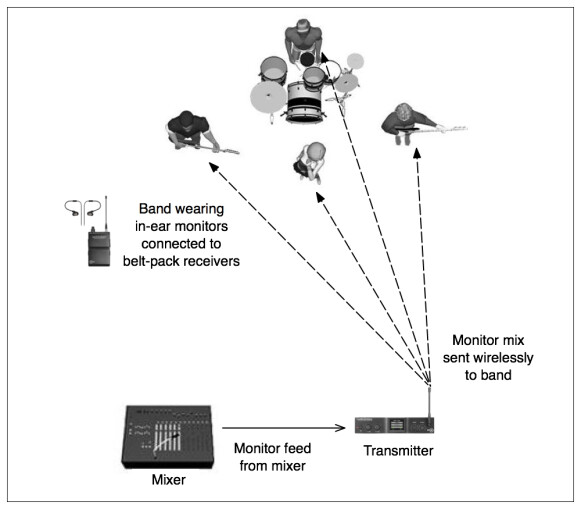Bands frequently run their stage monitors super loud in order to better hear themselves singing. But in the process, they're not only increasing stage volume to unbearable levels, they're also sabotaging the sound heard by the audience. Loud monitors frequently bleed into the front-of-house, causing a degradation of sound quality due to phase issues.
What’s more, the louder the monitors, the more their sound spills into the vocal mics, which results in additional problems in the house mix. Overly loud wedges also cause a vicious cycle, where musicians turn up their instruments to compensate for raised monitor levels, causing the vocalists to ask for more monitor, and on and on. So how can you hear yourself onstage, while keeping stage volume reasonable and not wrecking the sound out front? The solution is in-ear monitors.
In-ear monitors are not just for large touring acts anymore. Without spending much more than it would cost your keyboardist to buy a new stage piano, or your guitarist to get a new Les Paul, you can outfit a band with an in-ear system. It may take a while for everyone to get comfortable working that way, and there are some logistical hurdles to overcome, but it’s eminently doable, and, in fact, many club-level bands are doing it.
In-ear 101
For those unfamiliar, let me first describe how a basic wireless in-ear system operates. You start with a transmitter unit, into which you connect a line out of a monitor mix from the console (see diagram below).
The monitor signal is then sent wirelessly from the transmitter to the belt-pack receiver that each musician wears, into which are plugged the in-ear monitors (aka “ears”) themselves.
The monitors are designed to isolate outside sound. As a result, the musicians are hearing the instruments and vocals primarily through them, and ideally you won’t need wedges at all.
Without wedges, the stage volume is reduced significantly. And if the system is set up properly, the band will be able to hear themselves better than they ever could with wedges.
Making sure that each of the band members can hear themselves comfortably is the trick to making an in-ear system successful, and we’ll get to this in Part 2 of this series.
But first, lets look at some of the other benefits, besides improved sound quality out front, of using an in-ear system.
For one thing, it’s less dangerous to your hearing than wedges are. Yes, you will have volume coming directly into your ear canal from the in-ear monitors, but if you get things setup correctly, it shouldn’t have to be dangerously loud, and the potential to damage your hearing should be less than with loud wedges. Band members have individual control over the volume in their in-ears, thanks to output knobs on their beltpacks.
Singers should be able to hear themselves better, and in many in-ear systems there are ways to get “more me.” Obviously, if singers are able to comfortably hear themselves, it will help their singing. In wedge-based systems, they often have to sing louder than normal in order to hear themselves, which can make them more prone to pitch issues and voice strain.
Finally, whoever is mixing outfront will have an easier time controlling levels, because the sound from the stage will be bleeding less into the front of house, and the mix outfront will not be smeared the way it often is from wedge monitor bleed.
In part 2, we’ll look at some of the issues that in-ear systems present, and talk about how to overcome them.

